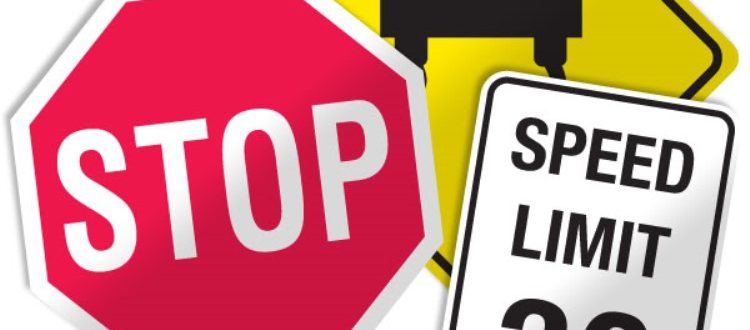The significant meanings of the various colors of highway, road, and street signs.
Question: What is the difference between green highway signs and blue highway signs?
There are several colors of signs that are used on the city streets, county roads, state highways, and interstate highways throughout the US (Canada and Europe will be somewhat different, but will still have their own color codes per country).
So, rather than give you a simple answer, as usual, I’ll give you a complex answer to a simple question. Actually, I’ll give you a color coded answer with visuals so you’ll have a good understanding of how highway, road, and street signs work.
White Signs with Black or Red Copy
The most common highway and road signs are white with black or red copy (mostly), with the exception of stop and yield signs. These signs are known as regulatory signs and include:
- Stop signs
- Yield signs
- Speed limit/zone signs (Including “Reduced Speed Ahead” type signs)
- Directional arrow signs (“One Way” signs fit into this sub-category)
- Lane control signs (such as “Left Turn Only” signs or “Bus Lane” signs)
- Passing signs (“Do Not Pass,” “Pass With Care” etc.)
- Prohibitive Signs (“Do Not Enter” and “No Trucks” are examples of this type of sign)
- Parking Signs (e.g. “Handicapped Parking” or “No Parking 12am to 6am”)
- Restrictive Signs (e.g. “Weight Limit 20,000 Lbs”)
While this list is certainly not exhaustive, it should give you a pretty good idea of regulatory signs as you’ve seen them all you life, obey them every day (hopefully), but just weren’t aware of the significance of white.
Yellow Signs
The next major category is the yellow signs. Yellow signs are generally permanent warning signs that are placed in areas where there is always a reason to warn you of something, like a sharp corner. Some examples of these signs are:
- Stop Ahead
- Winding Road (symbol only usually)
- Signal Ahead
- Narrow Bridge
- Lane Ends
- Bump
- Slippery When Wet
- Slow Children
- Truck Crossing
- Et Cetera – there are over 200 signs in this category
Yellow or Orange Signs
In the same category, with some crossover signs which can be yellow or orange, are the temporary warning signs. These signs are used for a temporary traffic situation and include over 100 signs as well, although between the yellow and orange category, the total is just over 300 signs. These signs include:
- Detour Signs
- Be Prepared to Stop
- Two Way Traffic
- Gravel
- Water Over Road
- Bump
- Lane Closed Ahead
- Road Work Ahead
- Flagger Ahead
- Road Closed
- Et Cetera
Yellow-Green Color Signs
A relatively small but important category of signs is the School Zone signs. These signs are now, in many area, a super reflective fluorescent yellow-green color, and signify that there are children present in the area at many times of day. These areas are often heavily patrolled by the police, so, if you don’t want a speeding ticket, these are signs you’ll really want to pay attention to. They include:
- School Zone symbol
- What Hours Zone Signs are in effect
- End School Zone
- Et Cetera
Green Signs
And (drum roll) finally, we’re getting to your question about blue versus green signs. I’ll start with green signs first. In the US, almost universally, green signs have to do with where you’re at and where you’re going. These include:
- School Zone symbol
- What Hours Zone Signs are in effect
- End School Zone
- Et Cetera
Blue Signs
The blue signs are also directional signs, but have to do more with things like hospitals or parks or fuel or lodging. These signs include:
- “H” signs – for hospital
- Tent symbol for camp area
- Gas Pump symbol for Fueling Station
- Rest Area signs
- Knife/Fork/Plate symbol for Restaurant
- Et Cetera
Brown Signs
Lastly, the brown signs. These signs are similar to the blue signs, but are generally pointing to recreational areas or motorist services within recreational area. The symbols are similar to the blue signs with some overlap. The symbols you’ll see on these signs include:
- Bear Symbol for a bear viewing area (kind of a scary sign, really!)
- Helicopter symbol for heli-pad
- Dog symbol for pet rest area
- Hiker symbol for hiking trail
- Bed symbol for lodging
- Downhill Skier symbol for an upcoming ski area
- Cross Country Skier symbol for XC skiing trails
- Sailboat symbol for sailing access area
- Et Cetera
So, there’s your highway sign primer. It covers most of the signs used on roads, streets, highways, and interstate highways in the US, so hopefully you got not only your original question answered, but several others too!
If you want to grab your very own street sign/s, GO HERE and learn more about the specs as specified by the United States Department of Transportation.
Popular Posts:




